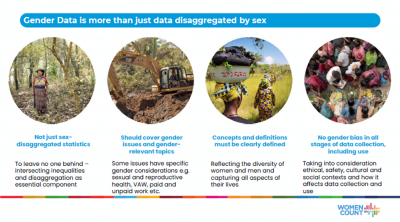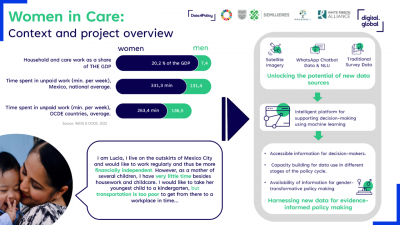Data Feminism Session 2 - Gender Data Gaps
December 15, 2022
Lea Voigt
“We need deliberate effort to increase gender data now and policies to measure the impact to […] improve the lives of women and girls” - Papa Seck, Chief of Research and Data Section, UN Women
In the second Data Feminism event, the GIZ Data Lab and the Data Pop Alliance welcomed Papa Alioune Seck, Chief of Research and Data at UN Women, who delivered a keynote on Gender Data, the gaps in Gender Data and why they matter for our work.
He was joined by the GIZ colleagues Daniela Torres Mendoza, Mariana Gonzalez Carrillo and Christin Schulze, together with external consultant Patricio Aguirre Arauz who shared some insights from their projects and their efforts to close Gender Data gaps.
Papa Seck (Chief of Research and Data Section, UN Women) on Gender Data gaps and why they matter for our work:

What is Gender Data?
When thinking about Gender Data, many people simply think about data disaggregated by sex. However, Gender Data is more than that. It should cover heterogeneous groups of women and focus on intersecting inequalities and disaggregation as essential components. For example, older women may have different demands than younger women – therefore it is important to collect data on both groups so that everyone is accurately represented in the data.
Gender Data should also cover a wide range of issues on gender. This includes topics such as violence against women, paid and unpaid work, sexual reproductive health but also topics that might not be gender explicit but affect women and men differently.
During the collection of Gender Data, it is important to avoid gender bias. This includes strategies such as interviewing several household members instead of only one (usually a male respondent) and assuming that they know about the assets and earnings of all household members, including the women.
Why does Gender Data matter?
Gender Data enables us to monitor progress and stay on track for the SDGs from a gender perspective. In addition to that, data is often guiding the formulation and monitoring of national policies. If not included in the data, women and girls are left behind in policymaking. Data is also guiding investments and monitoring budgets. Therefore, Gender Data is important to ensure that women and girls benefit equally from financial resources.
What are the most important Gender Data challenges?
Globally, we only have 42% of the data needed to measure gender-specific dimensions of the SDGs and with our current efforts it will take an estimated 22 years to close all Gender Data gaps. The existing data gaps hinder our most basic abilities to monitor progress and have effective evidence-based interventions.
There are three interrelated challenges that cause the Gender Data gaps:
- Weak policy space in legal and financial environments. Though overall funding for gender equality increased in 2020, funding for Gender Data dropped by 60% from 2019 to 2020, limiting the data collection.
- Technical challenges limit data production across key areas. Currently, there is little to no data available on key groups (e.g., women with disabilities, older women) and we lack the tools to improve data collection.
- Data is often still an afterthought. Instead of first collecting data and then deciding how we can use it, we should shift our attention and identify the use of data before the actual data collection.
How is UN Women addressing the Gender Data gaps?
UN Women launched a strategy for change called “Women Count”, a worldwide program that aims to address the three interrelated challenges introduced before. The program does not just aim to produce data but also tackle the root causes of the Gender Data gaps (e.g., issues related to planning, who is sitting at the table, capacity building). The goal is to create an enabling environment to increase data production and improve data accessibility and use.
Papa’s advice for GIZ projects:
When talking about Gender Data, it is important to focus on use and impact. Gender Data should be used to drive investments and continuously monitor results, impacts and change. GIZ projects should put emphasis on good and effective data – both internally and externally. The ultimate yardstick to judge success of development policy is the quantifiable change that it will make on the life of women and girls.
Examples of Gender Data Gaps from GIZ projects
Daniela Torres Mendoza (BMZ-funded project on Agenda 2030 in Mexico) & Mariana Carrillo (BMZ-funded global project Data4Policy) provide insights into the project “Women in Care” and how it aims to fill Gender Data gaps in Mexico:

The issue of unpaid care and housework is a worldwide socio-economic phenomenon that is present. On average, women spend twice as much time as men on unpaid care and housework in OECD countries. This figure increases up to almost three times as much in Mexico. Monetized, this would represent around 20% of Mexico’s GDP.
Data on women in these situations is often missing, resulting in data gaps that impact the way policy decisions are made. Without enough information, how can decision-makers prioritize resources, for example, for supporting women who want to access gainful employment? How can they know the barriers and potential enablers that would increase their chances of gaining more financial independence?
GIZ on behalf of the German Federal Ministry for Economic Cooperation and Development (BMZ) is addressing this challenge together with Mexico City’s government. The goal of the project is to fill the information gaps in decision- and policymaking, using new data sources, like satellite imagery, WhatsApp chatbot data as well as traditional survey data to promote women’s financial independence. The data is fed to an AI-powered platform that provides accessible information and supports capacity building for data use in different stages of the policy cycle to support policy makers in their decision-making process.
Here are the most important challenges encountered during the project:
- Data Ecosystems: Mexico City has strong capabilities of producing and collecting its own data. However, not all data is open or granular enough to provide information on different groups of women in the population. Additionally, accessing non-public data (owned by government or private) can be complicated and time consuming and is often accompanied by data privacy concerns.
- Capacities: The appetite for using data to inform decision-making exists but decision-makers often lack the capacities to analyse data – especially from non-traditional sources. In addition to that, insufficient data granularity sometimes requires complementary qualitative data. The additional data needs to be collected adhering to responsible data collection principles, requiring additional capacities that are often lacking.
- Use: Finally, ministries often lack the ability to use the insights from the data when making policies. Thus, part of the project is to provide workshops to support policy makers with applying the insights retrieved from the data in their decision-making. The questions raised are: How can one use the data in an ethical way? How to allocate limited resources to the most vulnerable groups? And how do we ensure that we really benefit vulnerable groups from data driven policies?
Christin Schulze & Partricio Aguirre Arauz (GIZ Sector Program Human Rights and GIZ PreViMujer program Ecuador, both financed by BMZ) discuss the project “Gender-based violence against LGBTIQ+ persons” which aims to close data gaps on LGBTI communities in Ecuador
Globally, data gaps for communities such as the LGBTIQ+ population continue to persist. This is also the case in Ecuador. Until today, Ecuador does not have any official quantitative national data on LGBTIQ+ persons and the last official study about the community’s needs is over ten years old.
The objective of the project is to conduct the first quantitative study in the country including the most representative sample possible at national level so that (1) the civil society organisations can strengthen the enforceability of their rights, (2) the government institutions can formulate public policies and (3) scientific communities can use the results for further studies.
Which actors are involved?
The GIZ Sector Program Human Rights and PreViMujer took the role of an articulent and brought different actors to the table - a milestone given the initial tensions between actors as well as diverging interests among the LGBTIQ+ community. Now there is an alliance of the public sector (Secretary for Diversity, National Institute for Statistics and Census), civil society organisations (26 non-profit organizations of the LGBTIQ+ community) and groups from the field of International Cooperation (Sector Program Human Rights in Germany, Program Prevention of Violence against Women in Ecuador).
What was the process?
Several steps were taken to make sure that all important factors in the study are included. The first step was to review similar studies about LGBTIQ+ persons in Latin America to identify the needs of the LGBTIQ+ community. Based on the literature review, different instruments such as questionnaires and databases were created to identify the main topics to study in this project. The instruments are used to enter a dialogue with the LGBTIQ+ organisations. The final step is field work, which includes training of the research team, observation and feedback.
The instrument
One of the key instruments for the study is a questionnaire with eleven sections on relevant LGBTIQ+ topics. Several of these sections have special issues related to vulnerability factors of human rights in the LGBTIQ+ population. Also, it includes a special section for discrimination. All these elements make it possible to better understand the needs and main vulnerability factors of the LGBTIQ+ population.
Learning experiences and next steps
One of the main learning experiences was how important it is to work with different actors. For example, some members of the government were very interested to support the LGBTIQ+ community but didn’t know which actions to take. Through a more fluent dialogue with civil society organisations, one can better understand the existing needs of the community and convey key issues to the government. Workshops play a key role in creating a dialogue between the different parties and including everyone in the conversation.
The next step of the project is to train people for the national survey in the coming year where the study will be implemented.
Stay tuned for Session 3...
The next session of the GIZ Data Feminism Event Series will address different approaches to close Gender Data Gaps and to use Gender Data for data-driven feminist approaches and advocacy. Stay tuned for the recording on this blog!